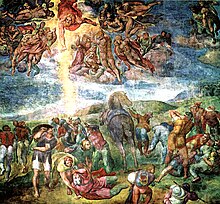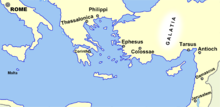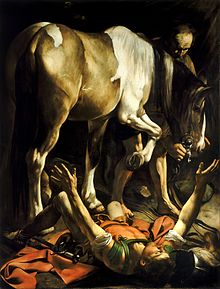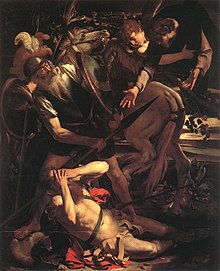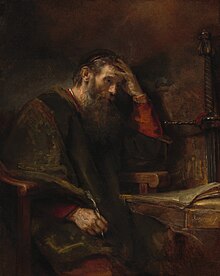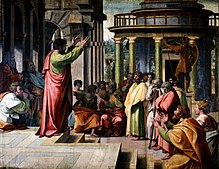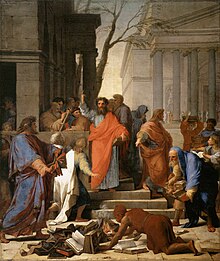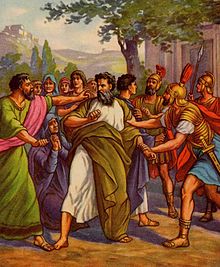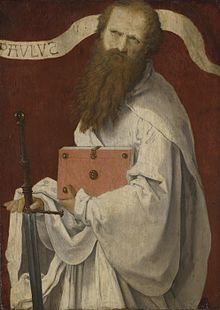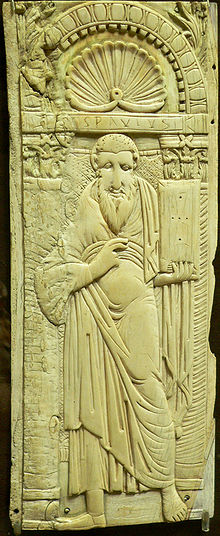Paul the Apostle
Biography
| Saint Paul | |
|---|---|
| Apostle of the Gentiles | |
 Saint Paul by Bartolomeo Montagna | |
Paul is generally considered one of the most important figures of the Apostolic Age and in the mid-30s to the mid-50s AD he founded several churches in Asia Minor and Europe. He took advantage of his status as both a Jew and a Roman citizen to minister to both Jewish and Roman audiences.
According to writings in the New Testament and prior to his conversion, Paul was dedicated to persecuting the early disciples of Jesus in the area of Jerusalem. In the narrative of the Acts of the Apostles (often referred to simply as Acts), Paul was traveling on the road from Jerusalem to Damascus on a mission to "arrest them and bring them back to Jerusalem" when the resurrected Jesus appeared to him in a great light. He was struck blind, but after three days his sight was restored by Ananias of Damascus and Paul began to preach that Jesus of Nazareth is the Jewish Messiah and the Son of God. Approximately half of the book of Acts deals with Paul's life and works.
Thirteen of the twenty-seven books in the New Testament have traditionally been attributed to Paul. Seven of the epistles are undisputed by scholars as being authentic, with varying degrees of argument about the remainder. Pauline authorship of the Epistle to the Hebrews is not asserted in the Epistle itself and was already doubted in the 2nd and 3rd centuries. It was almost unquestioningly accepted from the 5th to the 16th centuries that Paul was the author of Hebrews, but that view is now almost universally rejected by scholars. The other six are believed by some scholars to have come from followers writing in his name, using material from Paul's surviving letters and letters written by him that no longer survive. Other scholars argue that the idea of a pseudonymous author for the disputed epistles raises many problems.
Today, Paul's epistles continue to be vital roots of the theology, worship and pastoral life in the Catholic and Protestant traditions of the West, as well as the Orthodox traditions of the East. Paul's influence on Christian thought and practice has been characterized as being as "profound as it is pervasive", among that of many other apostles and missionaries involved in the spread of the Christian faith. Augustine of Hippo developed Paul's idea that salvation is based on faith and not "works of the law". Martin Luther's interpretation of Paul's writings influenced Luther's doctrine of sola fide.
Available sources
The main source for information about Paul's life is the material found in his epistles and in Acts. However, the epistles contain little information about Paul's past. The book of Acts recounts more information but leaves several parts of Paul's life out of its narrative, such as his probable but undocumented execution in Rome. Some scholars believe Acts also contradicts Paul's epistles on multiple accounts, in particular concerning the frequency of Paul's visits to the church in Jerusalem.
Sources outside the New Testament that mention Paul include:
- Clement of Rome's epistle to the Corinthians (late 1st/early 2nd century);
- Ignatius of Antioch's letter To the Romans (early 2nd century);
- Polycarp's letter to the Philippians (early 2nd century);
Names
It has been popularly assumed that Saul's name was changed when he became a follower of Jesus Christ, but that is not the case. His Jewish name was "Saul" (Hebrew: שָׁאוּל, Modern Sha'ûl, Tiberian Šāʼûl, "asked for, prayed for, borrowed"), perhaps after the biblical King Saul, a fellow Benjamite and the first king of Israel. According to the Book of Acts, he inherited Roman citizenship from his father. As a Roman citizen, he also bore the Latin name of "Paul"—in biblical Greek: Παῦλος (Paulos), and in Latin: Paulus. It was typical for the Jews of that time to have two names, one Hebrew, the other Latin or Greek.
Jesus called him "Saul, Saul" in "the Hebrew tongue" in the book of Acts, when he had the vision which led to his conversion on the Road to Damascus. Later, in a vision to Ananias of Damascus, "the Lord" referred to him as "Saul, of Tarsus". When Ananias came to restore his sight, he called him "Brother Saul".
In Acts 13:9, Saul is called "Paul" for the first time on the island of Cyprus—much later than the time of his conversion. The author (Luke) indicates that the names were interchangeable: "Saul, who also is called Paul." He thereafter refers to him as Paul, apparently Paul's preference since he is called Paul in all other Bible books where he is mentioned, including those that he authored. Adopting his Roman name was typical of Paul's missionary style. His method was to put people at their ease and to approach them with his message in a language and style to which they could relate, as in 1 Cor 9:19–23.
Biblical narrative
Early life
The two main sources of information by which we have access to the earliest segments of Paul's career are the Bible's Book of Acts and the autobiographical elements of Paul's letters to the early church communities. Paul was likely born between the years of 5 BC and 5 AD. The Book of Acts indicates that Paul was a Roman citizen by birth, more affirmatively describing his father as such, but Helmut Koester takes issue with the evidence presented by the text.
He was from a devout Jewish family in the city of Tarsus, one of the largest trade centers on the Mediterranean coast. It had been in existence several hundred years prior to his birth. It was renowned for its university. During the time of Alexander the Great, who died in 323 BC, Tarsus was the most influential city in Asia Minor.
Paul referred to himself as being "of the stock of Israel, of the tribe of Benjamin, a Hebrew of the Hebrews; as touching the law, a Pharisee".
The Bible reveals very little about Paul's family. Paul's nephew, his sister's son, is mentioned in Acts 23:16. Acts also quotes Paul referring to his father by saying he, Paul, was "a Pharisee, the son of a Pharisee" (Acts 23:6). In Romans 16:7 he states that his relatives, Andronicus and Junia, were Christians before he was and were prominent among the apostles.
The family had a history of religious piety (2 Timothy 1:3) Apparently the family lineage had been very attached to Pharisaic traditions and observances for generations. Acts says that he was in the tent-making profession. This was to become an initial connection with Priscilla and Aquila with whom he would partner in tentmaking and later become very important teammates as fellow missionaries.
While he was still fairly young, he was sent to Jerusalem to receive his education at the school of Gamaliel, one of the most noted rabbis in history. The Hillel school was noted for giving its students a balanced education, likely giving Paul broad exposure to classical literature, philosophy, and ethics. Some of his family may have resided in Jerusalem since later the son of one of his sisters saved his life there. Nothing more is known of his background until he takes an active part in the martyrdom of Stephen. Paul confesses that "beyond measure" he persecuted the church of God prior to his conversion. Although we know from his biography and from Acts that Paul could speak Hebrew, modern scholarship suggests that Koine Greek was his first language.
In his letters, Paul drew heavily on his knowledge of Stoic philosophy, using Stoic terms and metaphors to assist his new Gentile converts in their understanding of the revealed word of God.
He also owed much to his training in the law and the prophets, utilizing this knowledge to convince his Jewish countrymen of the unity of past Old Testament prophecy and covenants with the fulfilling of these in Jesus Christ. His wide spectrum of experiences and education gave the "Apostle to the Gentiles" the tools which he later would use to effectively spread the Gospel and to establish the church in the Roman Empire.
Conversion
Paul's conversion can be dated to 31–36 by his reference to it in one of his letters. In Galatians 1:16 Paul writes that God "was pleased to reveal his son to me." In 1 Corinthians 15:8, as he lists the order in which Jesus appeared to his disciples after his resurrection, Paul writes, "last of all, as to one untimely born, He appeared to me also."
According to the account in Acts, it took place on the road to Damascus, where he reported having experienced a vision of the resurrected Jesus. The account says that "he fell to the earth, and heard a voice saying unto him, Saul, Saul, why persecutest thou me?" Saul replied, "Who art thou, Lord? And the Lord said, I am Jesus whom thou persecutest: [it is] hard for thee to kick against the pricks (goads)."
According to the account in Acts 9:1–22, he was blinded for three days and had to be led into Damascus by the hand. During these three days, Saul took no food or water and spent his time in prayer to God. When Ananias of Damascus arrived, he laid his hands on him and said: "Brother Saul, the Lord, [even] Jesus, that appeared unto thee in the way as thou camest, hath sent me, that thou mightest receive thy sight, and be filled with the Holy Ghost." His sight was restored, he got up and was baptized. This story occurs only in Acts, not in the Pauline epistles.
The author of Acts of the Apostles may have learned of Paul's conversion from the church in Jerusalem, or from the church in Antioch, or possibly from Paul himself.
Post-conversion
In the opening verses of Romans 1, Paul provides a litany of his own apostolic appointment to preach among the Gentiles and his post-conversion convictions about the risen Christ.
- Paul described himself as
- a servant of Jesus Christ;
- having experienced an unforeseen, sudden, startling change, due to all-powerful grace – not the fruit of his reasoning or thoughts;
- having seen Christ as did the other apostles when Christ appeared to him as he appeared to Peter, to James, to the Twelve, after his Resurrection;
- being inflicted with a debilitating physical condition akin to having a handicap which he refers to as "a thorn in the flesh";
- called to be an apostle;
- set apart for the gospel of God.
- Paul described Jesus as
- having been promised by God beforehand through his prophets in the holy Scriptures;
- being the true messiah and the Son of God;
- having biological lineage from David ("according to the flesh");
- having been declared to be the Son of God in power according to the Spirit of holiness by his resurrection from the dead;
- being Jesus Christ our Lord;
- the One through whom we have received grace and apostleship to bring about the obedience of faith for the sake of his name among all the nations, "including you who are called to belong to Jesus Christ".
- Jesus
- lives in heaven;
- is God's Son;
- would soon return.
- The Cross
- he now believed Jesus' death was a voluntary sacrifice that reconciled sinners with God.
- The Law
- he now believed the law only reveals the extent of people's enslavement to the power of sin – a power that must be broken by Christ.
- Gentiles
- he had believed Gentiles were outside the covenant that God made with Israel;
- he now believed Gentiles and Jews were united as the people of God in Christ Jesus.
- Circumcision
- had believed circumcision was the rite through which males became part of Israel, an exclusive community of God's chosen people;
- he now believed that neither circumcision nor uncircumcision means anything, but that the new creation is what counts in the sight of God, and that this new creation is a work of Christ in the life of believers, making them part of the church, an inclusive community of Jews and Gentiles reconciled with God through faith.
- Persecution
- had believed his violent persecution of the church to be an indication of his zeal for his religion;
- he now believed Jewish hostility toward the church was sinful opposition that would incur God's wrath; he believed he was halted by Christ when his fury was at its height; It was "through zeal" that he persecuted the Church, and he obtained mercy because he had "acted ignorantly in unbelief".
- The Last Days
- had believed God's messiah would put an end to the old age of evil and initiate a new age of righteousness;
- he now believed this would happen in stages that had begun with the resurrection of Jesus, but the old age would continue until Jesus returns.
Paul is critical both theologically and empirically of claims of moral or lineal superiority of Jews while conversely strongly sustaining the notion of a special place for the Children of Israel.
There are debates as to whether Paul understood himself as commissioned to take the gospel to the Gentiles at the moment of his conversion.
Early ministry
After his conversion, Paul went to Damascus, where Acts 9 states he was healed of his blindness and baptized by Ananias of Damascus. Paul says that it was in Damascus that he barely escaped death. Paul also says that he then went first to Arabia, and then came back to Damascus. Paul's trip to Arabia is not mentioned anywhere else in the Bible, and some suppose he actually traveled to Mount Sinai for meditations in the desert. He describes in Galatians how three years after his conversion he went to Jerusalem. There he met James and stayed with Simon Peter for 15 days. Paul located Mount Sinai in Arabia in Galatians 4:24–25.
Paul asserted that he received the Gospel not from man, but directly by "the revelation of Jesus Christ". He claimed almost total independence from the Jerusalem community (possibly in the Cenacle), but agreed with it on the nature and content of the gospel. He appeared eager to bring material support to Jerusalem from the various growing Gentile churches that he started. In his writings, Paul used the persecutions he endured to avow proximity and union with Jesus and as a validation of his teaching.
Paul's narrative in Galatians states that 14 years after his conversion he went again to Jerusalem. It is not known what happened during this time, but both Acts and Galatians provide some details. At the end of this time, Barnabas went to find Paul and brought him back to Antioch.
When a famine occurred in Judea, around 45–46, Paul and Barnabas journeyed to Jerusalem to deliver financial support from the Antioch community. According to Acts, Antioch had become an alternative center for Christians following the dispersion of the believers after the death of Stephen. It was in Antioch that the followers of Jesus were first called "Christians".
First missionary journey
The author of Acts arranges Paul's travels into three separate journeys. The first journey, led initially by Barnabas, took Paul from Antioch to Cyprus then into southern Asia Minor (Anatolia), and finally returning to Antioch. In Cyprus, Paul rebukes and blinds Elymas the magician who was criticizing their teachings. From this point on, Paul is described as the leader of the group.
They sail to Perga in Pamphylia. John Mark leaves them and returns to Jerusalem. Paul and Barnabas go on to Pisidian Antioch. On Sabbath they go to the synagogue. The leaders invite them to speak. Paul reviews Israelite history from life in Egypt to King David. He introduces Jesus as a descendant of David brought to Israel by God. He said that his team came to town to bring the message of salvation. He recounts the story of Jesus' death and resurrection. He quotes from the Septuagint to assert that Jesus was the promised Christos who brought them forgiveness for their sins. Both the Jews and the "God-fearing" Gentiles invited them to talk more next Sabbath. At that time almost the whole city gathered. This upset some influential Jews who spoke against them. Paul used the occasion to announce a change in his mission which from then on would be to the Gentiles.
Interval at Antioch
Antioch served as a major Christian center for Paul's evangelism, and he remained there for "a long time with the disciples" at the conclusion of his first journey. The exact duration of Paul's stay in Antioch is unknown, with estimates ranging from nine months to as long as eight years.
Council of Jerusalem
A vital meeting between Paul and the Jerusalem church took place some time in the years 50–51, described in Acts 15:2 and usually seen as the same event mentioned by Paul in Galatians 2:1. The key question raised was whether Gentile converts needed to be circumcised. At this meeting, Paul states in his letter to the Galatians, Peter, James, and John accepted Paul's mission to the Gentiles.
The Jerusalem meetings are mentioned in Acts, and also in Paul's letters. For example, the Jerusalem visit for famine relief apparently corresponds to the "first visit" (to Peter and James only). F. F. Bruce suggested that the "fourteen years" could be from Paul's conversion rather than from his first visit to Jerusalem.
Incident at Antioch
Despite the agreement achieved at the Council of Jerusalem, Paul recounts how he later publicly confronted Peter in a dispute sometimes called the "Incident at Antioch", over Peter's reluctance to share a meal with Gentile Christians in Antioch because they did not strictly adhere to Jewish customs.
Writing later of the incident, Paul recounts, "I opposed [Peter] to his face, because he was clearly in the wrong", and says he told Peter, "You are a Jew, yet you live like a Gentile and not like a Jew. How is it, then, that you force Gentiles to follow Jewish customs?" Paul also mentions that even Barnabas, his traveling companion and fellow apostle until that time, sided with Peter.
The final outcome of the incident remains uncertain. The Catholic Encyclopedia suggests that Paul won the argument, because "Paul's account of the incident leaves no doubt that Peter saw the justice of the rebuke". However Paul himself never mentions a victory and L. Michael White's From Jesus to Christianity draws the opposite conclusion: "The blowup with Peter was a total failure of political bravado, and Paul soon left Antioch as persona non grata, never again to return".
The primary source account of the Incident at Antioch is Paul's letter to the Galatians.
Second missionary journey
Paul left for his second missionary journey from Jerusalem, in late Autumn 49, after the meeting of the Council of Jerusalem where the circumcision question was debated. On their trip around the Mediterranean sea, Paul and his companion Barnabas stopped in Antioch where they had a sharp argument about taking John Mark with them on their trips. The book of Acts said that John Mark had left them in a previous trip and gone home. Unable to resolve the dispute, Paul and Barnabas decided to separate; Barnabas took John Mark with him, while Silas joined Paul.
Paul and Silas initially visited Tarsus (Paul's birthplace), Derbe and Lystra. In Lystra, they met Timothy, a disciple who was spoken well of, and decided to take him with them. Paul and his companions, Silas and Timothy, had plans to journey to the southwest portion of Asia Minor to preach the gospel but during the night, Paul had a vision of a man of Macedonia standing and begging him to go to Macedonia to help them. After seeing the vision, Paul and his companions left for Macedonia to preach the gospel to them. The Church kept growing, adding believers, and strengthening in faith daily.
In Philippi, Paul cast a spirit of divination out of a servant girl, whose masters were then unhappy about the loss of income her soothsaying provided (Acts 16:16–24). They turned the city against the missionaries, and Paul and Silas were put in jail. After a miraculous earthquake, the gates of the prison fell apart and Paul and Silas could have escaped but remained; this event led to the conversion of the jailor (Acts 16:25–40). They continued traveling, going by Berea and then to Athens, where Paul preached to the Jews and God-fearing Greeks in the synagogue and to the Greek intellectuals in the Areopagus. Paul continued from Athens to Corinth.
Interval in Corinth
Around 50–52, Paul spent 18 months in Corinth. The reference in Acts to Proconsul Gallio helps ascertain this date (cf. Gallio Inscription). In Corinth, Paul met Priscilla and Aquila (Acts 18:2), who became faithful believers and helped Paul through his other missionary journeys. The couple followed Paul and his companions to Ephesus, and stayed there to start one of the strongest and most faithful churches at that time (Acts 18:18–21).
In 52, departing from Corinth, Paul stopped at the nearby village of Cenchreae to have his hair cut off, because of a vow he had earlier taken. It is possible this was to be a final haircut prior to fulfilling his vow to become a Nazirite for a defined period of time. With Priscilla and Aquila, the missionaries then sailed to Ephesus and then Paul alone went on to Caesarea to greet the Church there. He then traveled north to Antioch, where he stayed for some time (Greek: ποιησας χρονον, perhaps about a year), before leaving again on a third missionary journey. Some New Testament texts suggest that he also visited Jerusalem during this period for one of the Jewish feasts, possibly Pentecost. Textual critic Henry Alford and others consider the reference to a Jerusalem visit to be genuine and it accords with Acts 21:29, according to which Paul and Trophimus the Ephesian had previously been seen in Jerusalem.
Third missionary journey
According to Acts, Paul began his third missionary journey by travelling all around the region of Galatia and Phrygia to strengthen, teach and rebuke the believers. Paul then traveled to Ephesus, an important center of early Christianity, and stayed there for almost three years, probably working there as a tentmaker, as he had done when he stayed in Corinth. He is claimed to have performed numerous miracles, healing people and casting out demons, and he apparently organized missionary activity in other regions. Paul left Ephesus after an attack from a local silversmith resulted in a pro-Artemis riot involving most of the city. During his stay in Ephesus, Paul wrote four letters to the church in Corinth.
Paul went through Macedonia into Achaea (Acts 20:1–2) and stayed in Greece, probably Corinth, for three months (Acts 20:1–2) during 56–57 AD. Commentators generally agree that Paul dictated his Epistle to the Romans during this period. He then made ready to continue on to Syria, but he changed his plans and traveled back through Macedonia because of some Jews who had made a plot against him. In Romans 15:19 Paul wrote that he visited Illyricum, but he may have meant what would now be called Illyria Graeca, which was at that time a division of the Roman province of Macedonia. On their way back to Jerusalem, Paul and his companions visited other cities such as Philippi, Troas, Miletus, Rhodes, and Tyre. Paul finished his trip with a stop in Caesarea, where he and his companions stayed with Philip the Evangelist before finally arriving at Jerusalem.
Journey from Rome to Spain
Among the writings of the early Christians, Pope Clement I said that Paul was "Herald (of the Gospel of Christ) in the West", and that "he had gone to the extremity of the west". John Chrysostom indicated that Paul preached in Spain: "For after he had been in Rome, he returned to Spain, but whether he came thence again into these parts, we know not". Cyril of Jerusalem said that Paul, "fully preached the Gospel, and instructed even imperial Rome, and carried the earnestness of his preaching as far as Spain, undergoing conflicts innumerable, and performing Signs and wonders". The Muratorian fragment mentions "the departure of Paul from the city [of Rome] [5a] (39) when he journeyed to Spain".
Visits to Jerusalem in Acts and the epistles
This table is adapted from White, From Jesus to Christianity. Note that the matching of Paul's travels in the Acts and the travels in his Epistles is done for the reader's convenience and is not approved of by all scholars.
| Acts | Epistles |
|---|---|
|
|
|
|
|
|
|
|
|
|
Last visit to Jerusalem and arrest
In 57, upon completion of his third missionary journey, Paul arrived in Jerusalem for his fifth and final visit with a collection of money for the local community. Acts reports that he initially was warmly received. However, Acts goes on to recount how Paul was warned by James and the elders that he was gaining a reputation for being against the Law, saying "they have been told about you that you teach all the Jews who are among the Gentiles to forsake Moses, telling them not to circumcise their children or walk according to our customs". Paul underwent a purification ritual in order to give the Jews no grounds to bring accusations against him for not following their law.
After seven days in Jerusalem, some "Jews from Asia" (most likely from Roman Asia) accused Paul of defiling the temple by bringing gentiles into it. He was seized and dragged out of the temple by an angry mob. He narrowly escaped being killed by surrendering to a group of Roman centurions, who arrested him, put him in chains and took him to the tribune.
When a plot to kill Paul on his way to an appearance before the Jews was discovered, he was transported by night to Caesarea Maritima. He was held as a prisoner there for two years, until a new governor reopened his case in 59. When the governor suggested that he be sent back to Jerusalem for further trial, Paul exercised his right as a Roman citizen to "appeal unto Caesar". Finally, Paul and his companions sailed for Rome where Paul was to stand trial for his alleged crimes.
Acts recounts that on the way to Rome for his appeal as a Roman citizen to Caesar, Paul was shipwrecked on "Melita" (Malta), where the islanders showed him "unusual kindness" and where he was met by Publius. From Malta, he travelled to Rome via Syracuse, Rhegium and Puteoli.
Two years in Rome
He finally arrived in Rome around 60, where he spent another two years under house arrest. The narrative of Acts ends with Paul preaching in Rome for two years from his rented home while awaiting trial.
Irenaeus wrote in the 2nd century that Peter and Paul had been the founders of the church in Rome and had appointed Linus as succeeding bishop. Paul was not a bishop of Rome, nor did he bring Christianity to Rome since there were already Christians in Rome when he arrived there. Also, Paul wrote his letter to the church at Rome before he had visited Rome.Paul only played a supporting part in the life of the church in Rome.
Death
The date of Paul's death is believed to have occurred after the Great Fire of Rome in July 64, but before the last year of Nero's reign, in 68.
It is described in a number of sources:
- I Clement (95–96 AD) suggests that both Paul and Peter were martyred.
- There is an early tradition found in the writing of Ignatius, probably around 110 AD, that Paul was martyred.
- Dionysius of Corinth, in a letter to the Romans (166–174 AD), stated that Paul and Peter were martyred in Italy. Eusebius also cites the Dionysius passage.
- The Acts of Paul, an apocryphal work written around 160, describes the martyrdom of Paul. According to the Acts of Paul, Nero condemned Paul to death by decapitation.
- Tertullian in his Prescription Against Heretics (200 AD) writes that Paul had a similar death to that of John the Baptist, who was beheaded.
- Eusebius of Caesarea in his Church History (320 AD) testifies that Paul was beheaded in Rome and Peter crucified. He wrote that the tombs of these two apostles, with their inscriptions, were extant in his time; and quotes as his authority a holy man of the name of Caius.
- Lactantius wrote that Nero "crucified Peter, and slew Paul" (318 AD).
- Jerome in his De Viris Illustribus (On Illustrious Men) (392 AD) states that Paul was beheaded at Rome.
- John Chrysostom (c. 349–407) wrote that Nero knew Paul personally and had him killed.
- Sulpicius Severus says Nero killed Peter and Paul. (403 AD)
A legend later developed that his martyrdom occurred at the Aquae Salviae, on the Via Laurentina. According to this legend, after Paul was decapitated, his severed head rebounded three times, giving rise to a source of water each time that it touched the ground, which is how the place earned the name "San Paolo alle Tre Fontane" ("St Paul at the Three Fountains"). Also according to legend, Paul's body was buried outside the walls of Rome, at the second mile on the Via Ostiensis, on the estate owned by a Christian woman named Lucina. It was here, in the fourth century, that the Emperor Constantine the Greatbuilt a first church. Then, between the fourth and fifth centuries it was considerably enlarged by the Emperors Valentinian I, Valentinian II, Theodosius I, and Arcadius. The present-day Basilica of Saint Paul Outside the Walls was built there in 1800.
Remains
Caius in his Disputation Against Proclus (198 AD) mentions this of the places in which the remains of the apostles Peter and Paul were deposited: "I can point out the trophies of the apostles. For if you are willing to go to the Vatican or to the Ostian Way, you will find the trophies of those who founded this Church".
Jerome in his De Viris Illustribus (392 AD) writing on Paul's biography, mentions that "Paul was buried in the Ostian Way at Rome".
In 2002, an 8 foot long marble sarcophagus, inscribed with the words "PAULO APOSTOLO MART" ("Paul apostle martyr") was discovered during excavations around the Basilica of Saint Paul Outside the Walls on the Via Ostiensis. Vatican archaeologists declared this to be the tomb of Paul the Apostle in 2005. In June 2009, Pope Benedict XVI announced excavation results concerning the tomb. The sarcophagus was not opened but was examined by means of a probe, which revealed pieces of incense, purple and blue linen, and small bone fragments. The bone was radiocarbon-dated to the 1st or 2nd century. According to the Vatican, these findings support the conclusion that the tomb is Paul's.
Writings
Of the 27 books in the New Testament, 14 have been attributed to Paul; 7 of these are widely considered authentic and Paul's own, while the authorship of the other 7 is disputed. The undisputed letters are considered the most important sources since they contain what everyone agrees to be Paul's own statements about his life and thoughts. Theologian Mark Powell writes that Paul directed these 7 letters to specific occasions at particular churches. As an example, if the Corinthian church had not experienced problems concerning its celebration of the Lord's Supper, today we would not know that Paul even believed in that observance or had any opinions about it one way or the other. He asks if we might be ignorant of other matters simply because no crises arose that prompted Paul to comment on them.
Although approximately half of Acts deals with Paul's life and works, the Book of Acts does not refer to Paul writing letters. Historians believe that the author of Acts did not have access to any of Paul's letters. One piece of evidence suggesting this is that Acts never directly quotes from the Pauline epistles. Discrepancies between the Pauline epistles and Acts would further support the conclusion that the author of Acts did not have access to those epistles when composing Acts.
In Paul's writings, he provides the first written account of what it is to be a Christian and thus a description of Christian spirituality. His letters have been characterized as being the most influential books of the New Testament after the Gospels of Matthew and John.
Basic message
Paul's writings emphasized the crucifixion, Christ's resurrection and the Parousia or second coming of Christ. E. P. Sanders finds three major emphases in Paul's writings:
- His strongest emphasis was on the death, resurrection, and lordship of Jesus Christ. He preached that one's faith in Jesus assures that person a share in Jesus' life (salvation). He saw Jesus' death as being for the believers' benefit, not a defeat. Jesus died so that believers' sins would be forgiven.
- The resurrection of Jesus was of primary importance to Paul, as may be seen in his first letter to the Thessalonians, which is the earliest surviving account of conversion to Christianity.
- The resurrection brought the promise of salvation to believers. Paul taught that, when Christ returned, those who had died believing in Christ as the saviour of mankind would be brought back to life, while those still alive would be "caught up in the clouds together with them to meet the Lord in the air".
Sanders concludes that Paul's writings reveal what he calls the essence of the Christian message:
- God sent his Son.
- The Son was crucified for the sins of humanity.
- After being dead three days, the Son was raised from the dead, defeating death.
- The Son would soon return.
- Those in Christ will live with him forever.
- Followers are urged to live by a set apart (sanctified) standard – "And the very God of peace sanctify you wholly; and I pray God your whole spirit and soul and body be preserved blameless unto the coming of our Lord Jesus Christ".
Authorship
Seven of the 13 letters that bear Paul's name – Romans, 1 Corinthians, 2 Corinthians, Galatians, Philippians, 1 Thessalonians and Philemon – were until recently almost universally accepted as being entirely authentic (dictated by Paul himself). They are considered the best source of information on Paul's life and especially his thought.
Four of the letters (Ephesians, 1 and 2 Timothy and Titus) are widely considered pseudepigraphical, while the authorship of the other two is subject to debate.Colossians and 2 Thessalonians are thought by some to be "Deutero-Pauline" meaning they may have been written by Paul's followers after his death. Similarly, 1 Timothy, 2 Timothy, and Titus may be "Trito-Pauline" meaning they may have been written by members of the Pauline school a generation after his death. According to their theories, these disputed letters may have come from followers writing in Paul's name, often using material from his surviving letters. These scribes also may have had access to letters written by Paul that no longer survive.
The authenticity of Colossians has been questioned on the grounds that it contains an otherwise unparalleled description (among his writings) of Jesus as "the image of the invisible God", a Christology found elsewhere only in John's gospel. However, the personal notes in the letter connect it to Philemon, unquestionably the work of Paul. Internal evidence shows close connection with Philippians.
Ephesians is a letter that is very similar to Colossians, but is almost entirely lacking in personal reminiscences. Its style is unique. It lacks the emphasis on the cross to be found in other Pauline writings, reference to the Second Coming is missing, and Christian marriage is exalted in a way which contrasts with the reference in 1 Cor. 7:8–9. Finally, according to R.E. Brown, it exalts the Church in a way suggestive of a second generation of Christians, "built upon the foundation of the apostles and prophets" now past.
The defenders of its Pauline authorship argue that it was intended to be read by a number of different churches and that it marks the final stage of the development of Paul's thinking. It has been said, too, that the moral portion of the Epistle, consisting of the last two chapters, has the closest affinity with similar portions of other Epistles, while the whole admirably fits in with the known details of Paul's life, and throws considerable light upon them.
Three main reasons have been advanced by those who question Paul's authorship of 1 Timothy, 2 Timothy, and Titus – also known as the Pastoral Epistles.
- First, they have found a difference in these letters' vocabulary, style, and theology from Paul's acknowledged writings. Defenders of the authenticity say that they were probably written in the name and with the authority of the Apostle by one of his companions, to whom he distinctly explained what had to be written, or to whom he gave a written summary of the points to be developed, and that when the letters were finished, Paul read them through, approved them, and signed them.
- Second, some believe there is a difficulty in fitting them into Paul's biography as we have it. They, like Colossians and Ephesians, were written from prison but suppose Paul's release and travel thereafter.
- Third, 2 Thessalonians, like Colossians, is questioned by some on stylistic grounds, with some noting, among other peculiarities, a dependence on 1 Thessalonians – yet a distinctiveness in language from the Pauline corpus. This, again, is explainable by the possibility that Paul requested one of his companions to write the letter for him under his dictation.
Atonement
Paul wrote down much of the theology of atonement. Paul taught that Christians are redeemed from sin by Jesus' death and resurrection. His death was an expiation as well as a propitiation, and by Christ's blood peace is made between God and man. By grace, through faith, a Christian shares in Jesus' death and in his victory over death, gaining as a free gift a new, justified status of sonship.
Relationship with Judaism
Some scholars see Paul (or Saul) as completely in line with 1st-century Judaism (a Pharisee and student of Gamaliel as presented by Acts), others see him as opposed to 1st-century Judaism (see Marcionism), while the majority see him as somewhere in between these two extremes, opposed to "Ritual Laws" (for example the circumcision controversy in early Christianity) but in full agreement on "Divine Law". These views of Paul are paralleled by the views of Biblical law in Christianity.
Paul redefined the people of Israel, those he calls the "true Israel" and the "true circumcision" as those who had faith in the heavenly Christ, thus excluding those he called "Israel after the flesh" from his new covenant (Galatians 6:16; Philippians 3:3). He also held the view that the Torah given to Moses was valid "until Christ came," so that even Jews are no longer "under the Torah," nor obligated to follow the commandments or mitzvot as given to Moses (Galatians 3-4).
— Professor James D. Tabor for the Huffington Post
Paul's theology of the gospel accelerated the separation of the messianic sect of Christians from Judaism, a development contrary to Paul's own intent. He wrote that faith in Christ was alone decisive in salvation for Jews and Gentiles alike, making the schism between the followers of Christ and mainstream Jews inevitable and permanent. He argued that Gentile converts did not need to become Jews, get circumcised, follow Jewish dietary restrictions, or otherwise observe Mosaic laws to be saved. Nevertheless, in Romans he insisted on the positive value of the Law, as a moral guide.
E. P. Sanders' publications have since been taken up by Professor James Dunn who coined the phrase "The New Perspective on Paul". N.T. Wright, the Anglican Bishop of Durham, notes a difference in emphasis between Galatians and Romans, the latter being much more positive about the continuing covenant between God and his ancient people than the former. Wright also contends that performing Christian works is not insignificant but rather proof of having attained the redemption of Jesus Christ by grace (free gift received by faith). He concludes that Paul distinguishes between performing Christian works which are signs of ethnic identity and others which are a sign of obedience to Christ.
World to come
Paul believed that Jesus would return within his lifetime. Paul expected that Christians who had died in the mean time would be resurrected to share in God's kingdom, and he believed that the saved would be transformed, assuming supernatural bodies.
Paul's teaching about the end of the world is expressed most clearly in his letters to the Christians at Thessalonica. He assures them that the dead will rise first and be followed by those left alive.This suggests an imminent end but he is unspecific about times and seasons, and encourages his hearers to expect a delay. The form of the end will be a battle between Jesus and the man of lawlessness whose conclusion is the triumph of Christ.
Role of women
The second chapter of the first letter to Timothy – one of the six disputed letters – is used by many churches to deny women a vote in church affairs, reject women from serving as teachers of adult Bible classes, prevent them from serving as missionaries, and generally disenfranchise women from the duties and privileges of church leadership.
The KJV translation of this passage taken literally says that women in the churches are to have no leadership roles vis-à-vis men.
Fuller Seminary theologian J. R. Daniel Kirk finds evidence in Paul's letters of a much more inclusive view of women. He writes that Romans 16 is a tremendously important witness to the important role of women in the early church. Paul praises Phoebe for her work as a deaconess and Junia who is described by Paul in Scripture as being respected among the Apostles. It is Kirk's observation that recent studies have led many scholars to conclude that the passage in 1 Corinthians 14ordering women to "be silent" during worship was a later addition, apparently by a different author, and not part of Paul's original letter to the Corinthians.
Other scholars, such as Giancarlo Biguzzi, believe that Paul's restriction on women speaking in 1 Corinthians 14 is genuine to Paul but applies to a particular case where there were local problems of women – who were not allowed in that culture to become educated – asking questions or chatting during worship services. He does not believe it to be a general prohibition on any woman speaking in worship settings since in 1 Corinthians Paul affirms the right (responsibility) of women to prophesy.
There were women prophets in the highly patriarchal times throughout the Old Testament. The most common term for prophet in the Old Testament is nabi in the masculine form, and nebiah in the Hebrew feminine form, is used six times of women who performed the same task of receiving and proclaiming the message given by God. These women include Miriam, Aaron and Moses' sister,Deborah, the prophet Isaiah's wife, and Huldah, the one who interpreted the Book of the Law discovered in the temple during the days of Josiah. There were false prophetesses just as there were false prophets. The prophetess Noadiah was among those who tried to intimidate Nehemiah. Apparently they held equal rank in prophesying right along with Abraham, Isaac, Jacob, Moses, Elisha, Aaron, and Samuel.
Kirk's third example of a more inclusive view is Galatians 3:28:
In pronouncing an end within the church to the divisions which are common in the world around it, he concludes by highlighting the fact that "there were New Testament women who taught and had authority in the early churches, that this teaching and authority was sanctioned by Paul, and that Paul himself offers a theological paradigm within which overcoming the subjugation of women is an anticipated outcome".
Classicist Evelyn Stagg and theologian Frank Stagg believe that Paul was attempting to "Christianize" the societal household or domestic codes that significantly oppressed women and empowered men as the head of the household. The Staggs present a serious study of what has been termed the New Testament domestic code, also known as the Haustafel. The two main passages that explain these "household duties" are Paul's letters to the Ephesians 5:22 – 6:5 and to the Colossians 3:18–4:1. An underlying Household Code is also reflected in four additional Pauline letters and 1 Peter: 1 Timothy 2:1ff., 8ff.; 3:1ff., 8ff.; 5:17ff.; 6:1f.; Titus 2:1–10 and 1 Peter 2:13–3:9. Biblical scholars have typically treated the Haustafel in Ephesians as a resource in the debate over the role of women in ministry and in the home.
Margaret MacDonald argues that the Haustafel, particularly as it appears in Ephesians, was aimed at "reducing the tension between community members and outsiders".
E. P. Sanders has labeled the Apostle's remark in 1 Cor. 14:34–36 about women not making any sound during worship as "Paul's intemperate outburst that women should be silent in the churches". Women, in fact, played a very significant part in Paul's missionary endeavors:
- He became a partner in ministry with the couple Priscilla and Aquila who are specifically named seven times in the New Testament – always by their couple name and never individually. Of the seven times they are named in the New Testament, Priscilla's name appears first in five of those instances, suggesting to some scholars that she was the head of the family unit. They lived, worked, and traveled with the Apostle Paul, becoming his honored, much-loved friends and coworkers in Christ Jesus. In Romans 16:3–4, thought to have been written in 56 or 57, Paul sends his greetings to Priscilla and Aquila and proclaims that both of them "risked their necks" to save Paul's life.
- Chloe was an important member of the church in Corinth
- Phoebe was a "deacon" and a "benefactor" of Paul and others
- Romans 16 names eight other women active in the Christian movement, including Junia ("prominent among the apostles"), Mary ("who has worked very hard among you"), and Julia
- Women were frequently among the major supporters of the new Christian movement
Views on homosexuality
Most Christian traditions say Paul clearly portrays homosexuality as sinful in two specific locations: Romans 1:26–27, and 1 Corinthians 6:9–10. Another passage addresses the topic more obliquely: 1 Timothy 1:8–11. Since the nineteenth century, however, most scholars have concluded that 1 Timothy, along with 2 Timothy and Titus, are not original to Paul, but rather an unknown Christian writing in Paul's name some time in the late-first-to-mid-2nd century.
Influence on Christianity
Paul's influence on Christian thinking arguably has been more significant than any other New Testament author. Paul declared that "Christ is the end of the law",exalted the Christian church as the body of Christ, and depicted the world outside the Church as under judgment. Paul's writings include the earliest reference to the "Lord's Supper", a rite traditionally identified as the Christian communion or Eucharist. In the East, church fathers attributed the element of election in Romans 9 to divine foreknowledge. The themes of predestination found in Western Christianity do not appear in Eastern theology. Augustine's foundational work on the gospel as a gift (grace), on morality as life in the Spirit, on predestination, and on original sin all derives from Paul, especially Romans.
Modern theology
In his commentary The Epistle to the Romans (Ger. Der Römerbrief; particularly in the thoroughly re-written second edition of 1922) Karl Barth argued that the God who is revealed in the cross of Jesus challenges and overthrows any attempt to ally God with human cultures, achievements, or possessions.
In addition to the many questions about the true origins of some of Paul's teachings posed by historical figures as noted above, some modern theologians also hold that the teachings of Paul differ markedly from those of Jesus as found in the Gospels. Barrie Wilson states that Paul differs from Jesus in terms of the origin of his message, his teachings and his practices. Some have even gone so far as to claim that, due to these apparent differences in teachings, that Paul was actually no less than the "second founder" of Christianity (Jesus being its first).
Visit any church service, Roman Catholic, Protestant or Greek Orthodox, and it is the apostle Paul and his ideas that are central – in the hymns, the creeds, the sermons, the invocation and benediction, and of course, the rituals of baptism and the Holy Communion or Mass. Whether birth, baptism, confirmation, marriage or death, it is predominantly Paul who is evoked to express meaning and significance.
— Professor James D. Tabor for the Huffington post
Robert M. Price, in his book The Amazing Colossal Apostle: The Search for the Historical Paul, says "the Pauline epistles reveal themselves to the discerning reader to have exactly the same sort of limitation as the Gospels do: both are collections of fragments and pericopae contributed and fabricated by authors and communities of very different theological leanings".
As in the Eastern tradition in general, Western humanists interpret the reference to election in Romans 9 as reflecting divine foreknowledge.
Church tradition
Various Christian writers have suggested more details about Paul's life.
1 Clement, a letter written by the Roman bishop Clement of Rome around the year 90, reports this about Paul:
Commenting on this passage, Raymond Brown writes that while it "does not explicitly say" that Paul was martyred in Rome, "such a martyrdom is the most reasonable interpretation". Eusebius of Caesarea, who wrote in the 4th century, states that Paul was beheaded in the reign of the Roman Emperor Nero. This event has been dated either to the year 64, when Rome was devastated by a fire, or a few years later, to 67. According to one tradition, the church of San Paolo alle Tre Fontane marks the place of Paul's execution. A Roman Catholic liturgical solemnity of Peter and Paul, celebrated on June 29, commemorates his martyrdom, and reflects a tradition (preserved by Eusebius) that Peter and Paul were martyred at the same time. The Roman liturgical calendar for the following day now remembers all Christians martyred in these early persecutions; formerly, June 30 was the feast day for St. Paul. Persons or religious orders with special affinity for St. Paul can still celebrate their patron on June 30.
The apocryphal Acts of Paul and the apocryphal Acts of Peter suggest that Paul survived Rome and traveled further west. Some think that Paul could have revisited Greece and Asia Minor after his trip to Spain, and might then have been arrested in Troas, and taken to Rome and executed. A tradition holds that Paul was interred with Saint Peter ad Catacumbas by the via Appia until moved to what is now the Basilica of Saint Paul Outside the Walls in Rome. Bede, in his Ecclesiastical History, writes that Pope Vitalian in 665 gave Paul's relics (including a cross made from his prison chains) from the crypts of Lucina to King Oswy of Northumbria, northern Britain. Paul is considered the patron saint of London.
The Feast of the Conversion of Saint Paul is celebrated on January 25.
Muslim views
Muslims have long believed that Paul purposefully corrupted the original revealed teachings of Jesus, through the introduction of such elements as paganism, the making of Christianity into a theology of the cross, and introducing original sin and the need for redemption.
Sayf ibn Umar claimed that certain rabbis persuaded Paul to deliberately misguide early Christians by introducing what Ibn Hazm viewed as objectionable doctrines into Christianity. Ibn Hazm repeated Sayf's claims. Rabbi Jacob Qirqisani also believed that Paul created Christianity by introducing the doctrine of Trinity. Paul has been criticized by some modern Muslim thinkers. Syed Muhammad Naquib al-Attas wrote that Paul misrepresented the message of Jesus, and Rashid Rida accused Paul of introducing shirk (polytheism) into Christianity. Mohammad Ali Jouhar quoted Adolf von Harnack's critical writings of Paul.
In Sunni Muslim polemics, Paul plays the same role (of deliberately corrupting the early teachings of Jesus) as a later Jew, Abdullah ibn Saba', would play in seeking to destroy the message of Islam from within (by introducing proto-Shi'ite beliefs). Among those who supported this view were scholars Ibn Taymiyyah (who believed while Paul ultimately succeeded, Ibn Saba failed) and Ibn Hazm (who claimed that the Jews even admitted to Paul's sinister purpose).
Jewish views
Jewish interest in Paul is a recent phenomenon. Before the positive historical reevaluations of Jesus by some Jewish thinkers in the eighteenth and nineteenth centuries, he had hardly featured in the popular Jewish imagination and little had been written about him by the religious leaders and scholars. Arguably, he is absent from the Talmud and rabbinical literature, although he makes an appearance in some variants of the medieval polemic Toledot Yeshu (as a spy for the rabbis).
However, with Jesus no longer regarded as the paradigm of gentile Christianity, Paul's position became more important in Jewish historical reconstructions of their religion's relationship with Christianity. He has featured as the key to building barriers (e.g. Heinrich Graetz and Martin Buber) or bridges (e.g. Isaac Mayer Wise and Claude G. Montefiore) in interfaith relations, as part of an intra-Jewish debate about what constitutes Jewish authenticity (e.g. Joseph Klausner and Hans Joachim Schoeps), and on occasion as a dialogical partner (e.g. Richard L. Rubenstein and Daniel Boyarin).
He features in an oratorio (by Felix Mendelssohn), a painting (by Ludwig Meidner) and a play (by Franz Werfel), and there have been several novels about Paul (by Shalom Asch and Samuel Sandmel).Jewish philosophers (including Baruch Spinoza, Leo Shestov, and Jacob Taubes) and Jewish psychoanalysts (including Sigmund Freud and Hanns Sachs) have engaged with the apostle as one of the most influential figures in Western thought. Scholarly surveys of Jewish interest in Paul include those by Hagner (1980), Meissner (1996), and Langton (2010, 2011).
Literary analysis
Writing styles
British Jewish scholar Hyam Maccoby contended that the Paul as described in the book of Acts and the view of Paul gleaned from his own writings are very different people. Some difficulties have been noted in the account of his life. Paul as described in the Book of Acts is much more interested in factual history, less in theology; ideas such as justification by faith are absent as are references to the Spirit, according to Maccoby. He also pointed out that there are no references to John the Baptist in the Pauline Epistles, although Paul mentions him several times in the book of Acts.
Others have objected that the language of the speeches is too Lukan in style to reflect anyone else's words. Moreover, George Shillington writes that the author of Acts most likely created the speeches accordingly and they bear his literary and theological marks. Conversely, Howard Marshall writes that the speeches were not entirely the inventions of the author and while they may not be accurate word-for-word, the author nevertheless records the general idea of them.
F. C. Baur (1792–1860), professor of theology at Tübingen in Germany, the first scholar to critique Acts and the Pauline Epistles, and founder of the Tübingen School of theology, argued that Paul, as the "Apostle to the Gentiles", was in violent opposition to the original 12 Apostles. Baur considers the Acts of the Apostles were late and unreliable. This debate has continued ever since, with Adolf Deissmann (1866–1937) and Richard Reitzenstein (1861–1931) emphasising Paul's Greek inheritance and Albert Schweitzer stressing his dependence on Judaism.
Other views
In the second (and possibly) late first century, Gnosticism was a competing religious tradition to Christianity which shared some elements of theology.
Elaine Pagels, professor of religion at Princeton University and an authority on Gnosticism, declined to judge (in her book The Gnostic Paul) whether Paul was actually a Gnostic. Instead, she concentrated on how the Gnostics interpreted Paul's letters and how evidence from gnostic sources may challenge the assumption that Paul wrote his letters to combat "gnostic opponents" and to repudiate their statement that they possess secret wisdom.
Professor Robert Eisenman of California State University, Long Beach argues that Paul was a member of the family of Herod the Great. Eisenman makes a connection between Paul and an individual identified by Josephus as "Saulus", a "kinsman of Agrippa". Another oft-cited element of the case for Paul as a member of Herod's family is found in Romans 16:11 where Paul writes, "Greet Herodion, my kinsman".
According to Timo Eskola, early Christian theology and discourse was influenced by the Jewish Merkabah tradition. Similarly, Alan Segal and Daniel Boyarin regard Paul's accounts of his conversion experience and his ascent to the heavens as the earliest first person accounts we have of a Merkabah mystic in Jewish or Christian literature. Conversely, Timothy Churchill has argued that Paul's Damascus road encounter does not fit the pattern of Merkabah.
Among the critics of Paul the Apostle was Thomas Jefferson, a Deist, who wrote that Paul was the "first corrupter of the doctrines of Jesus." Christian anarchists, such as Leo Tolstoy and Ammon Hennacy, take a similar view.
F.F. Powell argues that Paul, in his epistles, made use of many of the ideas of the Greek philosopher Plato, sometimes even using the same metaphors and language.For example, in Phaedrus, Plato has Socrates saying that the heavenly ideals are perceived as though "through a glass dimly", Paul's language closely mirrors this phrase 1 Corinthians 13.
Physical appearance
The New Testament offers little if any information about the physical appearance of Paul, but several descriptions can be found in apocryphal texts. In the Acts of Paul he is described as "A man of small stature, with a bald head and crooked legs, in a good state of body, with eyebrows meeting and nose somewhat hooked".In the Latin version of the Acts of Paul and Thecla it is added that he had a red, florid face.
In The History of the Contending of Saint Paul his countenance is actually described as "ruddy with the ruddiness of the skin of the pomegranate". The Acts of Saint Peter confirms that Paul had a bald and shining head, with red hair. As summarised by Barnes, Chrysostom records that Paul's stature was low, his body crooked and his head bald. Lucian, in his Philopatris, describes Paul as "corpore erat parvo (he was small), contracto (contracted), incurvo (crooked), tricubitali (of three cubits, or four feet six)".
Nicephorus claims that Paul was a little man, crooked, and almost bent like a bow, with a pale countenance, long and wrinkled, and a bald head. Pseudo-Chrysostom echoes Lucian's height of Paul, referring to him as "the man of three cubits". Paul at one point compares himself as one who is like "a miscarried/aborted child".This however probably does not suggest some kind of deformity such as being crooked or hunch-backed, that tormented him, but rather his view of his worthiness to become an apostle.
Retrieved from: Paul_the_Apostle.Text is available under the Creative Commons Attribution-ShareAlike License
